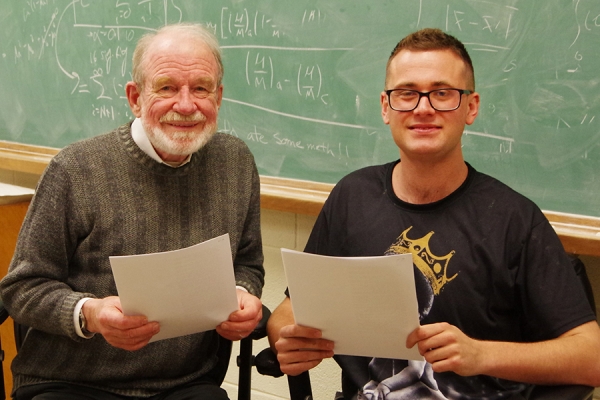 Physics professor emeritus Gordon Drake and his PhD student Aaron Bondy are part of an international team exploring the precise wavelength at which atoms become invisible to laser light.
Physics professor emeritus Gordon Drake and his PhD student Aaron Bondy are part of an international team exploring the precise wavelength at which atoms become invisible to laser light.
Researchers from the Department of Physics teamed up with a group of international researchers to determine the precise wavelength, or colour, at which atoms become invisible to laser light.
“The colour is carefully tuned until the interaction exactly vanishes — it is as if the atoms are no longer there, and cannot be detected,” says physics professor emeritus Gordon Drake.
“It is like turning the dial on your radio to find your favourite station, except in this case the station is exactly tuned-out.”
Dr. Drake and his PhD student Aaron Bondy are collaborating with Ken Baldwin at the Australian National University and Li-Yan Tang at the Wuhan Institute of Physics and Mathematics. The international effort will probe and test the fundamental laws of nature in a unique and unprecedented way. It was published today in the journal Science.
“Precision measurement and control lies at the heart of all modern technology from the GPS system to microchips and quantum computing,” says Drake.
“It is the quantized theory of charged particles interacting with electric and magnetic fields that underlies all of these applications, but no one knows if the theory is exact, or if something new lies beyond that is yet to be discovered. If so, it may open the way to a whole host of new applications.”
The role of Bondy and Drake, along with Dr. Tang, is to assemble all knowledge about the interaction of atoms with laser light from the last 100 years of quantum theory, and to use this as a basis to calculate the same tune-out frequency to see if it agrees with Dr. Bondy’s measurement.
“The theory involves such exotic effects as the interaction of an electron with its own electric field, and the polarization of the vacuum, or empty space, as if it were a real dielectric material,” Drake says. “The accuracy of the experiment, one part in three million, is more than sufficient to test for the presence of these exotic effects.”
The findings show that the new effects do indeed contribute to the tune-out frequency as expected, but there remains a discrepancy at the 90 per cent level of significance which may indicate the presence of further effects that are yet to be properly understood. Further work on both the theoretical and experimental sides is in progress.
